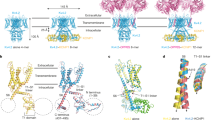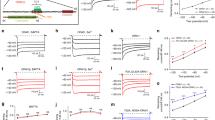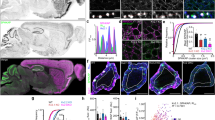Abstract
Multiple protein kinase C (PKC) isozymes are present in neurons, where they regulate a variety of cellular functions. Due to the lack of specific PKC isozyme inhibitors, it remains unknown how PKC acts on its selective target(s) and achieves its specific actions. Here we show that a PKC binding protein, enigma homolog (ENH), interacts specifically with both PKCε and N-type Ca2+ channels, forming a PKCε–ENH–Ca2+ channel macromolecular complex. Coexpression of ENH facilitated modulation of N-type Ca2+ channel activity by PKC. Disruption of the complex reduced the potentiation of the channel activity by PKC in neurons. Thus, ENH, by interacting specifically with both PKCε and the N-type Ca2+ channel, targets a specific PKC to its substrate to form a functional signaling complex, which is the molecular mechanism for the specificity and efficiency of PKC signaling.
This is a preview of subscription content, access via your institution
Access options
Subscribe to this journal
Receive 12 print issues and online access
$209.00 per year
only $17.42 per issue
Buy this article
- Purchase on Springer Link
- Instant access to full article PDF
Prices may be subject to local taxes which are calculated during checkout







Similar content being viewed by others
References
Catterall, W.A. Structure and function of neuronal Ca2+ channels and their role in neurotransmitter release. Cell. Calcium 24, 307–323 (1998).
Levitan, I.B. Modulation of ion channels by protein phosphorylation. How the brain works. Adv. Second Messenger Phosphoprotein Res. 33, 3–22 (1999).
Vaughan, P.F., Walker, J.H. & Peers, C. The regulation of neurotransmitter secretion by protein kinase C. Mol. Neurobiol. 18, 125–155 (1998).
Dempsey, E.C. et al. Protein kinase C isozymes and the regulation of diverse cell responses. Am. J. Physiol. 279, 429–438 (2000).
Tanaka, C. & Nishizuka, Y. The protein kinase C family for neuronal signaling. Annu. Rev. Neurosci. 17, 551–567 (1994).
Dekker, L.V. & Parker, P.J. Protein kinase C: a question of specificity. Trends Biochem. Sci. 19, 73–77 (1994).
Hofmann, J. The potential for isoenzyme-selective modulation of protein kinase C. FASEB J. 11, 649–669 (1997).
Way, K.J., Chou, E. & King, G.L. Identification of PKC-isoform-specific biological actions using pharmacological approaches. Trends Pharmacol. Sci. 21, 181–187 (2000).
Mochly-Rosen, D. Localization of protein kinases by anchoring proteins: a theme in signal transduction. Science 268, 247–251 (1995).
Pawson, T. & Scott, J.D. Signaling through scaffold, anchoring and adaptor proteins. Science 278, 2075–2080 (1997).
Mochly-Rosen, D. & Gordon, A.S. Anchoring proteins for protein kinase C: a means for isozyme selectivity. FASEB J. 12, 35–42 (1998).
Ron, D. & Kazanietz, M.G. New insights into the regulation of protein kinase C and novel phorbol ester receptors. FASEB J. 13, 1658–1676 (1999).
Zhang, J.F. et al. Distinctive pharmacology and kinetics of cloned neuronal Ca2+ channels and their possible counterparts in mammalian CNS neurons. Neuropharmacology 32, 1075–1088 (1993).
Dunlap, K., Luebke, J.I. & Turner, T.J. Exocytotic Ca2+ channels in mammalian central neurons. Trends Neurosci. 18, 89–98 (1995).
Swartz, K.J., Merritt, A., Bean, B.P. & Lovinger, D.M. Protein kinase C modulates glutamate receptor inhibition of Ca2+ channels and synaptic transmission. Nature 361, 165–168 (1993).
Yang, J. & Tsien, R.W. Enhancement of N- and L-type calcium channel currents by protein kinase C in frog sympathetic neurons. Neuron 10, 127–136 (1993).
Hell, J.W., Appleyard, S.M., Yokoyama, C.T., Warner, C. & Catterall, W.A. Differential phosphorylation of two size forms of the N-type calcium channel alpha 1 subunit which have different COOH termini. J. Biol. Chem. 269, 7390–7396 (1994).
Stea, A., Soong, T.W. & Snutch, T.P. Determinants of PKC-dependent modulation of a family of neuronal calcium channels. Neuron 15, 929–940 (1995).
Catterall, W.A. Modulation of sodium and calcium channels by protein phosphorylation and G proteins. Adv. Second Messenger Phosphoprotein Res. 31, 159–181 (1997).
Malenka, R.C., Madison, D.V. & Nicoll, R.A. Potentiation of synaptic transmission in the hippocampus by phorbol esters. Nature 321, 175–177 (1986).
Wheeler, D.B., Randall, A. & Tsien, R.W. Roles of N-type and Q-type Ca2+ channels in supporting hippocampal synaptic transmission. Science 264, 107–111 (1994).
Kuroda, S. et al. Protein-protein interaction of zinc finger LIM domains with protein kinase C. J. Biol. Chem. 271, 31029–31032 (1996).
Ueki, N. et al. Isolation, tissue expression, and chromosomal assignment of a human LIM protein gene, showing homology to rat enigma homologue (ENH). J. Hum. Genet. 44, 256–260 (1999).
Dawid, I.B., Breen, J.J. & Toyama, R. LIM domains: multiple roles as adapters and functional modifiers in protein interactions. Trends Genet. 14, 156–162 (1998).
Bach, I. The LIM domain: regulation by association. Mech. Dev. 91, 5–17 (2000).
Williams, M.E. et al. Structure and functional expression of an ω-conotoxin-sensitive human N-type calcium channel. Science 257, 389–395 (1992).
Sudhof, T.C. et al. Synapsins: mosaics of shared and individual domains in a family of synaptic vesicle phosphoproteins. Science 245, 1474–1480 (1989).
Shapiro, M.S., Zhou, J. & Hille, B. Selective disruption by protein kinases of G-protein-mediated Ca2+ channel modulation. J. Neurophysiol. 76, 311–320 (1996).
Dodge, F. Jr. & Rahamimoff, R. Co-operative action a calcium ions in transmitter release at the neuromuscular junction. J. Physiol. (Lond.) 193, 419–432 (1967).
Mintz, I.M., Sabatini, B.L. & Regehr, W.G. Calcium control of transmitter release at a cerebellar synapse. Neuron 15, 675–688 (1995).
Zhang, J.F., Ellinor, P.T., Aldrich, R.W. & Tsien, R.W. Multiple structural elements in voltage-dependent Ca2+ channels support their inhibition by G proteins. Neuron 17, 991–1003 (1996).
Johnson, J.A., Gray, M.O., Chen, C.-H. & Mochly-Rosen, D. A protein kinase C translocation inhibitor as an isozyme-selective antagonist of cardiac function. J. Biol. Chem. 271, 24962–24966 (1996).
Gray, P.C., Scott, J.D. & Catterall, W.A. Regulation of ion channels by cAMP-dependent protein kinase and A-kinase anchoring proteins. Curr. Opin. Neurobiol. 8, 330–334 (1998).
Fraser, I.D. & Scott, J.D. Modulation of ion channels: a 'current' view of AKAPs. Neuron 23, 423–426 (1999).
De Waard, M. et al. Direct binding of G-protein betagamma complex to voltage-dependent calcium channels. Nature 385, 446–450 (1997).
Herlitze, S., Hockerman, G.H., Scheuer, T. & Catterall, W.A. Molecular determinants of inactivation and G protein modulation in the intracellular loop connecting domains I and II of the calcium channel alpha1A subunit. Proc. Natl. Acad. Sci. USA 94, 1512–1516 (1997).
Qin, N., Platano, D., Olcese, R., Stefani, E. & Birnbaumer, L. Direct interaction of gbetagamma with a C-terminal gbetagamma-binding domain of the Ca2+ channel alpha1 subunit is responsible for channel inhibition by G protein-coupled receptors. Proc. Natl. Acad. Sci. USA 94, 8866–8871 (1997).
Zamponi, G.W., Bourinet, E., Nelson, D., Nargeot, J. & Snutch, T.P. Crosstalk between G proteins and protein kinase C mediated by the calcium channel alpha1 subunit. Nature 385, 442–446 (1997).
Lee, A. et al. Ca2+/calmodulin binds to and modulates P/Q-type calcium channels. Nature 399, 155–159 (1999).
Peterson, B.Z., DeMaria, C.D., Adelman, J.P. & Yue, D.T. Calmodulin is the Ca2+ sensor for Ca2+-dependent inactivation of L-type calcium channels. Neuron 22, 549–558 (1999).
Zuhlke, R.D., Pitt, G.S., Deisseroth, K., Tsien, R.W. & Reuter, H. Calmodulin supports both inactivation and facilitation of L-type calcium channels. Nature 399, 159–162 (1999).
Dolphin, A.C. Voltage-dependent calcium channels and their modulation by neurotransmitters and G proteins. Exp. Physiol. 80, 1–36 (1995).
Klauck, T.M. et al. Coordination of three signaling enzymes by AKAP79, a mammalian scaffold protein. Science 271, 1589–1592 (1996).
Pawson, T. Protein modules and signalling networks. Nature 373, 573–580 (1995).
Sheng, M. & Sala, C. PDZ domains and the organization of supremolecular complexes. Annu. Rev. Neurosci. 24, 1–29 (2001).
Saito, N. et al. Cellular and intracellular localization of epsilon-subspecies of protein kinase C in the rat brain; presynaptic localization of the epsilon-subspecies. Brain Res. 607, 241–248 (1993).
Khasar, S.G. et al. A novel nociceptor signaling pathway revealed in protein kinase C epsilon mutant mice. Neuron 24, 253–260 (1999).
Zugaza, J.L., Sinnett-Smith, J., Van Lint, J. & Rozengurt, E. Protein kinase D (PKD) activation in intact cells through a protein kinase C-dependent signal transduction pathway. EMBO J. 15, 6220–6230 (1996).
Zhou, Q., Ruiz-Lozano, P., Martone, M.E. & Chen, J. Cypher, a striated muscle-restricted PDZ and LIM domain-containing protein, binds to alpha-actinin-2 and protein kinase C. J. Biol. Chem. 274, 19807–19813 (1999).
Acknowledgements
We thank R. Pittman, D. Manning, J. Eberwine, J. Meinkoth and C. Deutsch for helpful discussion and critical comments, J. Field for initial help with yeast two-hybrid screening, Z. Lu for oocytes, and M. Maronski and M. Dichter for help with hippocampal neuron cultures. This work was supported by the Penn Research Foundation, American Heart Association, National Institutes of Health (NS39355, J.F.Z.) and a NARSAD young investigator award (Y.M.H.).
Author information
Authors and Affiliations
Corresponding author
Ethics declarations
Competing interests
The authors declare no competing financial interests.
Rights and permissions
About this article
Cite this article
Maeno-Hikichi, Y., Chang, S., Matsumura, K. et al. A PKCε–ENH–channel complex specifically modulates N-type Ca2+ channels. Nat Neurosci 6, 468–475 (2003). https://doi.org/10.1038/nn1041
Received:
Accepted:
Published:
Issue Date:
DOI: https://doi.org/10.1038/nn1041
This article is cited by
-
Adiponectin receptor 1-mediated stimulation of Cav3.2 channels in trigeminal ganglion neurons induces nociceptive behaviors in mice
The Journal of Headache and Pain (2023)
-
A novel effect of PDLIM5 in α7 nicotinic acetylcholine receptor upregulation and surface expression
Cellular and Molecular Life Sciences (2022)
-
Bayesian logistic regression in detection of gene–steroid interaction for cancer at PDLIM5 locus
Journal of Genetics (2016)
-
Peripheral PDLIM5 expression in bipolar disorder and the effect of olanzapine administration
BMC Medical Genetics (2012)
-
The role of protein kinase C epsilon in neural signal transduction and neurogenic diseases
Frontiers of Medicine (2011)



